Last Updated on August 21, 2023 by Allison Price
While lip twitching can have legitimate uses, ear twitching should be avoided.
Q Just bought my first horse. Do you think lip- or ear-twitching is effective in distracting horses or subduing them? Is either type of twitching dangerous?
A It is possible to restrain horses during veterinary procedures to complete a task or to prevent injury to horse and human. Twitches are a useful tool to accomplish this. They apply pressure to the horse’s lips or ears. Twitching can also be accomplished by grasping the horse’s lip or ear with a hand. However, most people associate the device known as twitches (especially when it is done on the lips) with this action.
Three possible explanations for how twitches subdue horses are: pain, distraction, and decreased sensitivity. There are also possibilities that horses may be subdued by a combination of these factors. Some studies have found that horses are subdued by lip twitching, which is a pain-relieving (analgesic) effect.
Twitches in Action
Based on stress indicators such as heart rate, heart-rate variability and cortisol levels, a 2016 study provided insight into horses’ responses to the lip twitch or ear twitch. To assess the activity of the autonomic nervous system, it measured heart rate variability and heart-rate variability before and after the use of twitches. Heart-rate variability refers to the time interval between two heartbeats. Variability is desirable because it indicates efficiency and health. To assess stress levels, the study also examined salivary cortisol before and after twitches.
There were twelve geldings (including Quarter Horses and Thoroughbreds) that were divided into two groups. They had a median age of 13. Researchers used lip twitches and ear twitches on one group. The lip twitch was found to significantly decrease heart rate and increase variability in heart rate when used for up to five minutes. The lip twitch increased heart rate and heart-rate variability when it was applied for longer than five minutes. When the ear twitch was applied for more than 5 minutes, it significantly increased horses’ heart rates, decreased heart-rate variability and increased salivary cortisol levels. All of these are undesirable reactions.
The lip twitch has been shown to decrease horses’ heart rate when they are exposed to painful stimuli (see box). It is believed to release beta-endorphins which subdue them through an analgesic mechanism similar to acupuncture.
Although it is possible to conclude that a lip twitch may initially subdue horses by a calming, possibly pain-killing effect (at most for the first five minutes), an ear tick clearly triggers a stressed response and immobilizes horses through fear or pain.
An ear twitch can cause immobility. This is a common response seen in horses and other animals. The delicate ear tissues may also be damaged by ear twitching.
Anecdotal evidence also suggests that horses may become more sensitive to ear twitching and are therefore harder to manage long-term.
I have concluded that the lip twitch should be used only when trying to subdue a horse humanely, but not for more than five minutes. After that time, all analgesic benefits have been lost and it is worth considering an anesthetic. Avoid ear twitching completely
Horse-handlers are discouraged.



